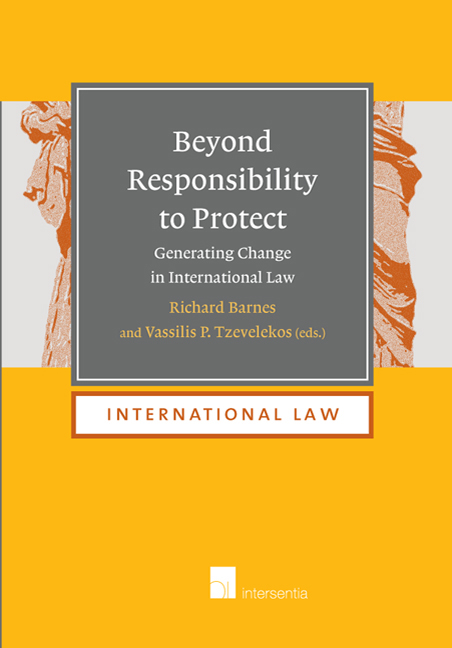Book contents
- Frontmatter
- Dedication
- Foreword
- Acknowledgements
- Contents
- Table of Cases
- List of Authors
- Introduction
- Part I The Moral Underpinnings and Political Ends of R2p
- Part II International Institutions And Their Role In R2p
- PART III De Facto Regimes and Non-State Actors Within a State And as a State
- Part IV R2p and Due Dilligence Regarding the Conduct of Corporations
- Part V The Interaction Between R2p And Humanitarian Law Obligations To Protect Civilian Populations
- PART VI R2p and International Criminal Law Beyond the Four R2p Crimes
- Part VII R2p and its Possible Impact on the Law of International Responsibility
- The ICJ Judgment in the Genocide Convention Case: Is R2P Drawing New Horizons for the Law on State Responsibility?
- Responsibility to Protect as a Basis for ‘Judicial Humanitarian Intervention’
- Military Commanders as Bystanders to International Crimes: A Responsibility to Protect?
- Commentary: R2P as a Transforming and Transformative Concept in the Context of Responsibility as Liability
- Part VIII Concluding Observations
- Index
The ICJ Judgment in the Genocide Convention Case: Is R2P Drawing New Horizons for the Law on State Responsibility?
from Part VII - R2p and its Possible Impact on the Law of International Responsibility
Published online by Cambridge University Press: 19 September 2018
- Frontmatter
- Dedication
- Foreword
- Acknowledgements
- Contents
- Table of Cases
- List of Authors
- Introduction
- Part I The Moral Underpinnings and Political Ends of R2p
- Part II International Institutions And Their Role In R2p
- PART III De Facto Regimes and Non-State Actors Within a State And as a State
- Part IV R2p and Due Dilligence Regarding the Conduct of Corporations
- Part V The Interaction Between R2p And Humanitarian Law Obligations To Protect Civilian Populations
- PART VI R2p and International Criminal Law Beyond the Four R2p Crimes
- Part VII R2p and its Possible Impact on the Law of International Responsibility
- The ICJ Judgment in the Genocide Convention Case: Is R2P Drawing New Horizons for the Law on State Responsibility?
- Responsibility to Protect as a Basis for ‘Judicial Humanitarian Intervention’
- Military Commanders as Bystanders to International Crimes: A Responsibility to Protect?
- Commentary: R2P as a Transforming and Transformative Concept in the Context of Responsibility as Liability
- Part VIII Concluding Observations
- Index
Summary
INTRODUCTION
The judgment of the International Court of Justice (ICJ) in the Application of the Genocide Convention case marks an historical milestone, classifying one of the worst tragedies of the last century – the Srebrenica massacre – as genocide. Nonetheless, scholars have not assessed the conclusions reached by the Court unanimously: while some consider the judgment perfectly in line with the case law of the International Criminal Tribunal for the former Yugoslavia (ICTY), others criticise ICJ's reasoning on reparation. In some cases, this disapproval is very strong: ‘the judgement itself has already been called “timid justice” and “wishy-washy” as well as “perverse”’. Undoubtedly, the decision raises many controversial issues, because it deals with state responsibility for genocide (for the first time in history) and could be possibly seen as opening the door to the use of force in order to comply with the duty to prevent that crime.
Quite apart from these criticisms, the decision is of major importance to those studying the evolution of responsibility to protect (R2P). Although the Court did not explicitly refer to the doctrine, with its reasoning framed in terms of state responsibility for failing to prevent genocide, it attested the existence of a kind of responsibility to protect on the part of the international community. More specifically, the Court recognised, for the first time, a state's responsibility for not having prevented a violation that occurred outside its territory, at the hands of persons not under its control, apparently considering decisive that Serbia had the means to prevent the genocide in Srebrenica and that it manifestly refrained from using these means. It has thus identified a ‘responsibility to protect beyond borders’, which appears to reflect one of the two elements underpinning R2P, its ‘international dimension’, i.e. the international community's complementary responsibility to protect, arising whenever a state is unable or unwilling to protect the individuals under its jurisdiction. The decision contributes to the delineation of the international community's responsibility in the field of prevention, which is pertinent to both the Second and Third Pillars of R2P, regarding, respectively, ‘international assistance and capacity-building’, and ‘timely and decisive response’.
- Type
- Chapter
- Information
- Beyond Responsibility to ProtectGenerating Change in International Law, pp. 351 - 366Publisher: IntersentiaPrint publication year: 2016

